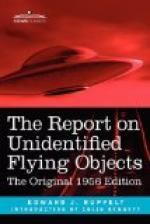To anyone who had anything to do with flying saucers, the summer of 1952 was just one big swirl of UFO reports, hurried trips, midnight telephone calls, reports to the Pentagon, press interviews, and very little sleep.
If you can pin down a date that the Big Flap started, it would probably be about June 1.
It was also on June 1 that we received a good report of a UFO that had been picked up on radar. June 1 was a Sunday, but I’d been at the office all day getting ready to go to Los Alamos the next day. About 5:00P.M. the telephone rang and the operator told me that I had a long-distance call from California. My caller was the chief of a radar test section for Hughes Aircraft Company in Los Angeles, and he was very excited about a UFO he had to report.
That morning he and his test crew had been checking out a new late-model radar to get it ready for some tests they planned to run early Monday morning. To see if their set was functioning properly, they had been tracking jets in the Los Angeles area. About midmorning, the Hughes test engineer told me, the jet traffic had begun to drop off, and they were about ready to close down their operation when one of the crew picked up a slow-moving target coming across the San Gabriel Mountains north of Los Angeles. He tracked the target for a few minutes and, from the speed and altitude, decided that it was a DC-3. It was at 11,000 feet and traveling about 180 miles an hour toward Santa Monica. The operator was about ready to yell at the other crew members to shut off the set when he noticed something mighty odd— there was a big gap between the last and the rest of the regularly spaced bright spots on the radarscope. The man on the scope called the rest of the crew in because DC-3’s just don’t triple their speed. They watched the target as it made a turn and started to climb over Los Angeles. They plotted one, two, three, and then four points during the target’s climb; then one of the crew grabbed a slide rule. Whatever it was, it was climbing 35,000 feet per minute and traveling about 550 miles an hour in the process. Then as they watched the scope, the target leveled out for a few seconds, went into a high-speed dive, and again leveled out at 55,000 feet. When they lost the target, it was heading southeast somewhere near Riverside, California.
During the sighting my caller told me that when the UFO was only about ten miles from the radar site two of the crew had gone outside but they couldn’t see anything. But, he explained, even the high-flying jets that they had been tracking hadn’t been leaving vapor trails.
The first thing I asked when the Hughes test engineer finished his story was if the radar set had been working properly. He said that as soon as the UFO had left the scope they had run every possible check on the radar and it was O.K.
I was just about to ask my caller if the target might not have been some experimental airplane from Edwards AFB when he second-guessed me. He said that after sitting around looking at each other for about a minute, someone suggested that they call Edwards. They did, and Edwards’ flight operations told them that they had nothing in the area.




